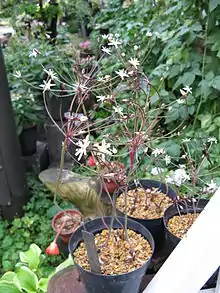| Strumaria | |
|---|---|
 | |
| Strumaria watermeyeri, in habitat near Nieuwoudtville, South Africa | |
| Scientific classification | |
| Kingdom: | Plantae |
| Clade: | Tracheophytes |
| Clade: | Angiosperms |
| Clade: | Monocots |
| Order: | Asparagales |
| Family: | Amaryllidaceae |
| Subfamily: | Amaryllidoideae |
| Genus: | Strumaria Jacq. |
| Synonyms[1] | |
| |

Strumaria is a genus of African plants in Amaryllis family, subfamily Amaryllidoideae.[2] The genus is known in nature only from South Africa, Lesotho and Namibia.[3] Almost all species flower in the autumn and are cultivated as ornamental bulbous plants.
Description
Species of Strumaria are deciduous bulbous plants. Their bulbs are generally small, around 7–35 mm (0.3–1.4 in) in diameter with a fibrous bulb tunic. Usually two leaves are produced, although there may be up to six. The flowers generally appear in the autumn with the arrival of the rains; the leaves may appear before, with, or after the flowers. The inflorescence is 20–40 cm (8–16 in) tall, with an umbel of two to 30 flowers, generally carried on long pedicels. Most species have white flowers, although they may also be pink or yellow. The six stamens are joined to the style, at least at the base. Strumaria is distinguished from other genera in the family Amaryllidaceae by the presence of a thickening at the base of the style, except in Strumaria spiralis, previously placed in its own genus Carpolyza. The seeds are reddish-green when ripe, with a diameter of 2–5 mm (0.1–0.2 in). When dry, the fruiting heads detach from the scape and are rolled away by the wind, thus dispersing the seeds.[4]
Species
Accepted (as of April 2022):[5][6]
- Strumaria aestivalis Snijman – Northern Cape Province
- Strumaria argillicola G.D.Duncan – Northern Cape Province
- Strumaria barbarae Oberm. – Namibia, Northern Cape Province
- Strumaria bidentata Schinz – Namibia, Northern Cape Province
- Strumaria chaplinii (W.F.Barker) Snijman – Western Cape Province
- Strumaria discifera Marloth ex Snijman – Western Cape Province, Northern Cape Province
- Strumaria gemmata Ker Gawl. – Western Cape Province, Northern Cape Province, Eastern Cape Province, Free State
- Strumaria hardyana D.Müll.-Doblies & U.Müll.-Doblies – Namibia
- Strumaria karooica (W.F.Barker) Snijman – Western Cape Province, Northern Cape Province
- Strumaria karoopoortensis (D.Müll.-Doblies & U.Müll.-Doblies) Snijman – Western Cape Province, Northern Cape Province
- Strumaria leipoldtii (L.Bolus) Snijman – Western Cape Province
- Strumaria luteoloba Snijman – Namibia, Northern Cape Province
- Strumaria massoniella (D.Müll.-Doblies & U.Müll.-Doblies) Snijman – Northern Cape Province
- Strumaria merxmuelleriana (D.Müll.-Doblies & U.Müll.-Doblies) Snijman – Northern Cape Province
- Strumaria perryae Snijman – Northern Cape Province
- Strumaria phonolithica Dinter – Namibia
- Strumaria picta W.F.Barker – Northern Cape Province
- Strumaria prolifera Snijman – Northern Cape Province
- Strumaria pubescens W.F.Barker – Western Cape Province, Northern Cape Province
- Strumaria pygmaea Snijman – Western Cape Province, Northern Cape Province
- Strumaria salteri W.F.Barker – Western Cape Province
- Strumaria speciosa Snijman – Namibia
- Strumaria spiralis (L'Hér.) W.T.Aiton – Western Cape Province
- Strumaria tenella (L.f.) Snijman – Western Cape Province, Northern Cape Province, Lesotho
- Strumaria truncata Jacq. – Western Cape Province, Northern Cape Province, Namibia
- Strumaria unguiculata (W.F.Barker) Snijman – Western Cape Province, Northern Cape Province
- Strumaria villosa Snijman – Northern Cape Province
- Strumaria watermeyeri L.Bolus – Northern Cape Province
- Formerly included[5]
A few names have been coined using the name Strumaria, applied to species now considered better suited to other genera (Hessea and Libertia).
- Strumaria chilensis - Libertia chilensis
- Strumaria crispa - Hessea cinnamomea
- Strumaria stellaris - Hessea stellaris
Distribution and habitat
Species of Strumaria are native to South Africa (the Cape Provinces and the Free State), Lesotho and Namibia.[1] All but one species are found in the winter rainfall area of Southern Africa, to the west and southwest, with the highest concentration in the highlands of Namaqualand. The exception is Strumaria tenella subsp. orientalis, found to the east in the Free State and Lesotho.[4]
Cultivation
Some Strumaria species are cultivated as ornamental bulbous plants, particularly for their autumn flowering period. Although they will survive a minimum temperature of 0 °C (32 °F), a higher minimum of 8 °C (46 °F) is recommended, for example in a cool greenhouse. The medium in which they are grown needs to be free-draining. They can be propagated from seeds, which lack dormancy and so need to be sown as soon as possible after being shed.[4]
References
- 1 2 "Strumaria", World Checklist of Selected Plant Families, Royal Botanic Gardens, Kew, retrieved 2013-09-03
- ↑ Stevens, P.F., Angiosperm Phylogeny Website: Asparagales: Amaryllidoideae
- ↑ Germishuizen, G.; Meyer, N.L. (2003), "Plants of Southern Africa: an annotated checklist", Strelitzia, National Botanical Institute, Pretoria, 14 (i–vi): 1–1231
- 1 2 3 Grossi, Alberto (2014), "Strumaria in cultivation", The Plantsman, (New Series), 13 (4): 222–225
- 1 2 "Search for Strumaria", World Checklist of Selected Plant Families, Royal Botanic Gardens, Kew, retrieved 2022-04-02
- ↑ South African National Biodiversity Institute, Red List of South African Plants, genus Strumaria
External links
- Strumaria at the Pacific Bulb Society